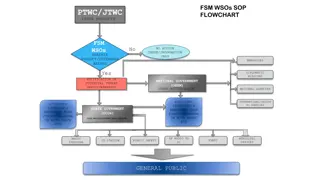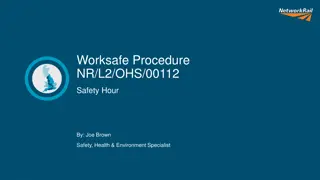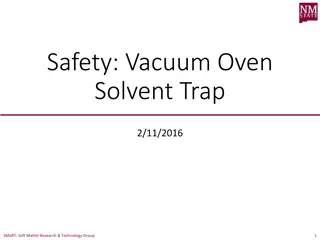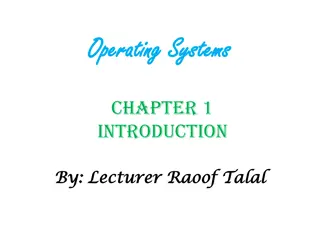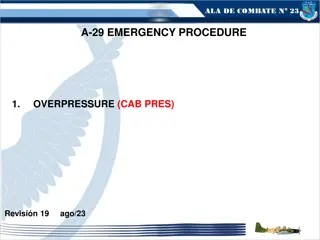Safe Operating Procedure (SOP)
Create a Safe Operating Procedure (SOP) for construction tasks, emphasizing safety and precision. Identify tasks, gather information, assess risks, develop, and train personnel for effective implementation. Enhance safety culture and operational efficiency.
Download Presentation

Please find below an Image/Link to download the presentation.
The content on the website is provided AS IS for your information and personal use only. It may not be sold, licensed, or shared on other websites without obtaining consent from the author.If you encounter any issues during the download, it is possible that the publisher has removed the file from their server.
You are allowed to download the files provided on this website for personal or commercial use, subject to the condition that they are used lawfully. All files are the property of their respective owners.
The content on the website is provided AS IS for your information and personal use only. It may not be sold, licensed, or shared on other websites without obtaining consent from the author.
E N D
Presentation Transcript
Safe Operating Procedure (SOP) "SOPs are our safety roadmap. These guidelines prioritize precision and safety in tasks. This document ensures a secure culture, minimizing risks and enhancing operational efficiency." www.hsestudyguide.com
Safe Operating Procedure (SOP) A Safe Operating Procedure (SOP) is a documented step-by-step guide that outlines how to perform a task or activity safely. It's crucial in industries like construction where risks are high. Here's a breakdown of developing an SOP along with a sample example for construction safety: www.hsestudyguide.com
Steps to Develop a Safe Operating Procedure (SOP): 1. Identify the Task:Determine the specific task or activity that requires an SOP. In construction, it could be "Operating Heavy Machinery." 2. Gather Information:Research best practices, regulations, and safety guidelines related to the task. Consult with experts and workers experienced in the field. 3. Break Down the Steps:Outline each step of the task in a clear, sequential manner. Include safety precautions for each step. 4. Risk Assessment:Identify potential hazards and risks associated with each step. Assess the level of risk and determine necessary safety measures. www.hsestudyguide.com
Steps to Develop a Safe Operating Procedure (SOP): 5. Develop the SOP:Write a detailed document including: Title:"Safe Operating Procedure for Operating Heavy Machinery" Purpose:Explain why the SOP is necessary and its intended outcomes. Equipment Needed:List required tools, machinery, or safety gear. Step-by-Step Instructions:Detail each step with clear instructions. Safety Precautions:Include measures to mitigate risks at each step. Emergency Procedures:Outline what to do in case of accidents or emergencies. Review and Approval:Have the SOP reviewed and approved by relevant authorities or experts. 6. Training:Train personnel thoroughly on the SOP, ensuring they understand and can implement the safety measures. www.hsestudyguide.com
Sample Example -Construction Safety SOP for Operating Heavy Machinery: Title: Safe Operating Procedure for Operating Heavy Machinery Purpose:To ensure the safe operation of heavy machinery to prevent accidents and injuries. Equipment Needed: Heavy machinery (e.g., excavator, bulldozer) Personal Protective Equipment (PPE) -hard hat, gloves, steel-toed boots, reflective vest www.hsestudyguide.com
Step-by-Step Instructions: 1. Pre-Check Inspection: Safety Precautions: Inspect the machinery for any visible damages or malfunctions. Check fuel, oil, and hydraulic fluid levels. Ensure all safety features and warning signals are functional. Only certified operators should conduct inspections. Do not operate machinery if any faults are found. Report to supervisors. www.hsestudyguide.com
2. Start-Up Procedure: Start the machinery according to manufacturer guidelines. Allow the machine to warm up before use. Safety Precautions: Operate machinery only from the designated driver's seat. Keep bystanders clear of the operating area. www.hsestudyguide.com
3. During Operation: Follow designated routes and paths. Maintain safe speeds and be aware of surroundings. Safety Precautions: Always wear seatbelts while operating. Avoid distractions and remain focused on the task. www.hsestudyguide.com
4. Shutdown Procedure: Follow manufacturer guidelines to power down the machinery. Engage parking brake and secure the equipment. Safety Precautions: Ensure the area is clear of personnel before shutting down. Conduct post-operation checks for any issues or damages. www.hsestudyguide.com
Emergency Procedures: In case of malfunction or accident, immediately turn off the machinery. Evacuate the area and alert supervisors or emergency services. Review and Approval:This SOP has been reviewed and approved by [Supervisor's Name] on [Date]. Training:All personnel operating heavy machinery must undergo training on this SOP and demonstrate competency before operating machinery independently. www.hsestudyguide.com
Remember SOPs should be periodically reviewed and updated to reflect any changes in regulations, equipment, or best practices in the field. www.hsestudyguide.com























